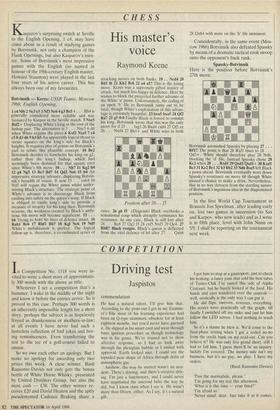CHESS
His master's voice
Raymond Keene
Kasparov's surprising switch at Seville to the English Opening, 1 c4, may have come about as a result of studying games by Botvinnik, not only a champion of the Flank Openings, but also Kasparov's men- tor. Some of Botvinnik's most impressive games with the English (so named in honour of the 19th-century English master, Howard Staunton) were played in the last four years of his active career. This has always been one of my favourites.
Botvinnik — Keres: USSR Teams, Moscow 1966; English Opening.
1 c4 N16 2 Nc3 e5 3 Nf3 Ne6 4 g3 Bc5 4 . . . Bb4 is generally considered more reliable and was favoured by Karpov in the Seville match. 5 Nxe5 Bxf2+ Displacing White's king at the cost of the bishop pair. The alternative is 5 . . . Nxe5 6 d4 when White regains the piece.6 Kxf2 Nxe5 7 e4 c5 8 d3 d6 9 h3 h5 An apparently logical thrust to create squares on the king's side for Black's knights. It requires play of genius on Botvinnik's part to refute this plausible concept. 10 Be2 Botvinnik decides to fianchetto his king on g2, rather than the king's bishop, which had seemingly been destined for that square ever since White's 4th move. 10 . . . Nh7 11 Kg2 h4 12 g4 Ng5 13 Be3 Bd7 14 Qd2 Ne6 15 b4 An impressive strategic advance, displaying Botvin- nik's breadth of vision. If now 15 . . . cxb4 16 Nd5 will regain the White pawn whilst under- mining Black's structure. The strategic point of White's advance is to discourage Black from castling into safety on the queen's wing. If Black is obliged to castle kings side to provide a measure of security for his king then, Botvinnik reasons, the weakness created by Black's ambi- tious 9th move will become significant. 15 b6 Trying to hold his lines of defence intact. 16 Rabl Bch 17 Rhfl Bbl 18 Kgl Nc6 19 Nd5 White's mobilisation is perfect. The logical follow-up is, therefore, a co-ordinated series of attacking moves on both flanks. 19 . . Ncd4 20 Bdl f6 21 Kh2 Bch 22 a4 a5? This is the losing move. Keres was a supremely gifted master of attack, but much less happy in defence. Here he wishes to block the projected further advance of the White 'a' pawn. Unfortunately, the ceding of an open 'b' file to Botvinnik turns out to be fatal, thOugh White's exploitation of this advan- tage is extremely beautiful. 23 bxa5 bxa5 24 Qf2 Raj 25 g5 0-0 Finally Black is forced to commit his king. Botvinnik wrote that this was the only move for if 25 . . . fxg5 26 Bxd4 cxd4 27 Qf5 or 26 . . Nxd4 27 Bh5+ and White wins in both Position after 26... f5 cases. 26 g6 15 (Diagram) Black overlooks a sensational coup which abruptly terminates his resistance. In any case, Black is still lost after 26 . . . Be8 27 Qg2 f5 28 exf5 Nxf5 29 Qe4. 27 RbS!! Black resigns. Black's queen is deflected from the vital defence of h4 after 27 . . . Qxb8
28 Qxh4 with mate on the 'h' file imminent.
Coincidentally, in the same event (Mos- cow 1966) Botvinnik also defeated Spassky by means of a dramatic tactical rook swoop onto the opponent's back rank.
Spassky-Botvinnik
Here is the position before Botvinnik's 27th move: Botvinnik astonished Spassky by playing 27 . . . RH!! The point is that 28 Rxfl loses to 28 . . . Qd3+. White should therefore play 28 Nd6, blocking the 'd' file. Instead Spassky chose 28 kc2 when 28 . . . Rxd1 29 Qxdl Qxdl+ 30 Kxdl Be3 31 Ke213c1 32 b3 Bb2 33 Nd6 BxeS left Black a pawn ahead. Botvinnik eventually wore down Spassky's resistance on move 68 though White missed a chance to make a draw. Nevertheless, that in no way detracts from the startling nature of Botvinnik's ingenious idea in the diagrammed position.
In the first World Cup Tournament in Brussels Jon Speelman, after leading early on, lost two games in succession (to Sax and KarpoV, who now leads) and as I write is in fifth place, level with John Nunn on 5/9. I shall be reporting on the tournament next week.






























































 Previous page
Previous page